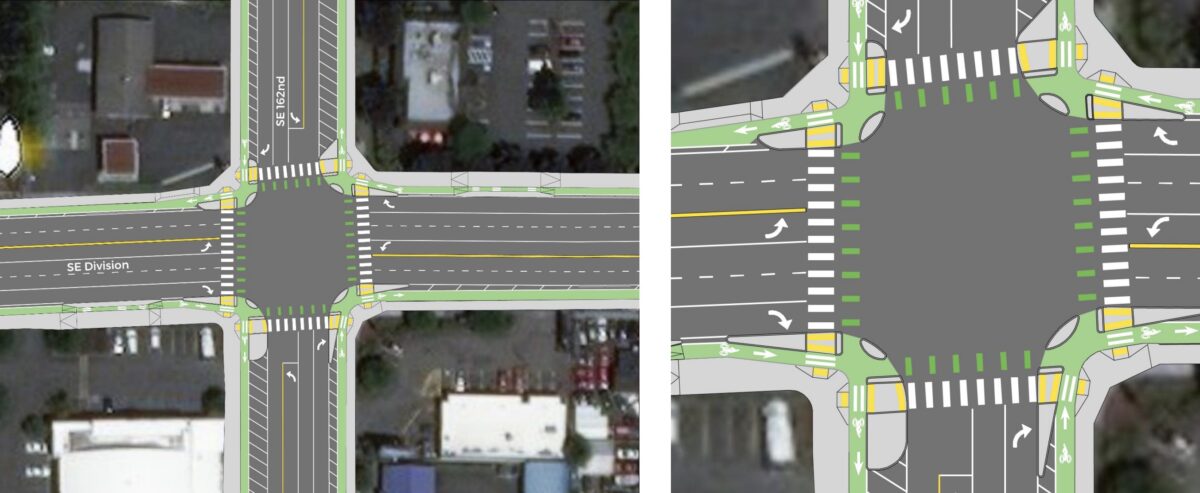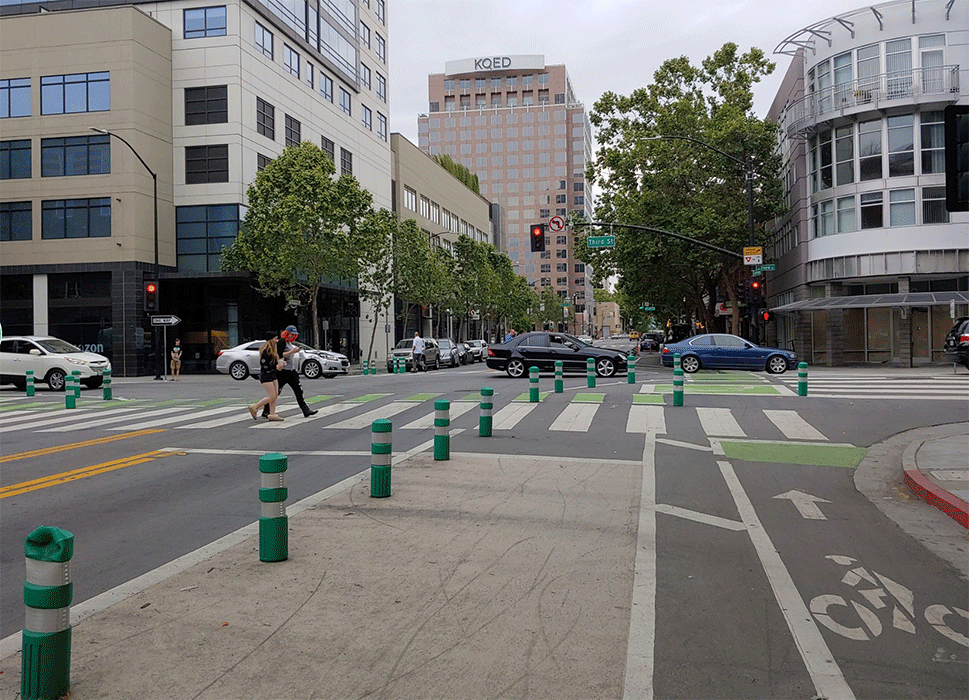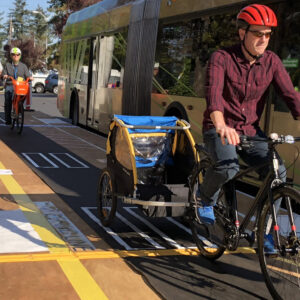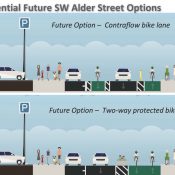
Staff working on TriMet’s Division Transit Project dropped a bit of a bombshell at the end of an advisory committee meeting earlier this week: They plan to build protected intersections at SE 122nd, 148th, and 162nd.
Protected intersections are a big deal. They are considered the safest way to handle bicycle traffic at what’s typically considered the weakest link in a safe facility. According to the National Highway Traffic Safety Administration, 43% of urban cycling fatalities occur at intersections.
“This design can reduce the likelihood of high-speed vehicle turns, improve sight lines, and dramatically reduce the distance and time during which people on bikes are exposed to conflicts.”
— National Association of City Transportation Officials (NACTO) on protected intersections
TriMet has spent five years planning the $175 million Division Transit Project and is now just six months away from the start of construction. The main goal is to speed up and boost capacity of buses to help more people reap the benefits of reliable, affordable, carfree transportation. TriMet says the 15 miles of “enhanced service” between downtown Portland and Gresham will speed up travel times an average of 15-20%.
We’ve recently focused on how bicycle users would interact with the new station designs; but we hadn’t heard anything about protected intersections until Tuesday night.
The plans were shared during a presentation (PDF) to the joint meeting of the Portland Bureau of Transportation’s bicycle and pedestrian advisory committees. TriMet says the designs are still in development and they’re working with PBOT to further vet them and make changes if necessary.
Protected intersections were first fleshed out by Portland planner Nick Falbo (who now works for PBOT) in 2014. Since then, over a dozen U.S. have installed them; but Portland hasn’t. We hoped to see one on the West Burnside project (currently under construction), but because of the off-set nature of the intersection and other compromises made during the design process, it’s not a perfect example.
Advertisement
 (Before-and-after of a protected intersection in San Jose, CA. GIF made from images taken from NACTO website).
(Before-and-after of a protected intersection in San Jose, CA. GIF made from images taken from NACTO website).
In their just-released design guide, the National Association of City Transportation Officials (NACTO) writes that protected intersections are, “Physically separated crossings that provide a high degree of comfort and safety for people of all ages and abilities. This design can reduce the likelihood of high-speed vehicle turns, improve sight lines, and dramatically reduce the distance and time during which people on bikes are exposed to conflicts.”
TriMet Project Manager Jesse Stemmler told us they intend to use the treatment on Division because the typical way to handle left turns for bicycle riders — a “two-stage turn” with green queue boxes — won’t work given the traffic volumes and other operational issues at these intersections. “We instead needed to create a protected space that would still allow for right turns and bus through movement, while allowing for refuge space for people bicycling and walking, with signal phasing protection from right turning traffic (no right turn on red) for both.”
Here’s more from TriMet on their rationale for the design:
The protected intersection design would narrow roadway crossing distances and exposure time for people walking, and provide physical protection between the bike lane and the intersection. It would provide space for left-turning bicycles to queue outside of the motor vehicle travel lanes while making a two-stage turn. This will allow the signal to be operated with concurrent left and right turn phasing for motor vehicles, which will reduce delay for buses on Division by keeping them in the travel lane and allowing for queue jumps.
This would be a huge upgrade to these intersections. Let’s hope (and do what we can to make sure) they don’t get value-engineered or compromised out of the project.
Construction of the Division Transit Project is expected to start in November with service to begin in 2022. Learn more in our archives or at TriMet.org/Division
— Jonathan Maus: (503) 706-8804, @jonathan_maus on Twitter and jonathan@bikeportland.org
Never miss a story. Sign-up for the daily BP Headlines email.
BikePortland needs your support.






Thanks for reading.
BikePortland has served this community with independent community journalism since 2005. We rely on subscriptions from readers like you to survive. Your financial support is vital in keeping this valuable resource alive and well.
Please subscribe today to strengthen and expand our work.
This is actually a huge development. PBOT has tried so many ideas with mixed results, but we know from the Dutch experiment that protected intersections are extremely effective. I hope this can become the standard at all high crash intersections!
Actually, protected intersections have been around far longer than 2014, both overseas and in the USA, but Nick did a fantastic job of articulating their design to other planners and engineers nationwide, making them a bit more standard and acceptable to conservative communities.
Having ridden some version of these in Europe, I can see an advantage at busy intersections, but they will take some adjustment by American riders. American riders will need to adjust to mixing with pedestrians even when they have the green light. Pedestrians waiting to cross the street to your left will be milling about in the bike lane. Locals may not be the ones milling about in the bike lane, but half the people on the streets can be tourists, some are even Americans.
IMO, from your image for 162nd, all 4 corners need to be at least as sharp as the upper left-hand corner one. The others still allow cars to turn too fast.
The intersections described are at least Truck Access for freight, meaning the corners should accommodate 40- and 50-foot trailers for local deliveries. Smaller radii corners are not compatible with this function.
Or just require smaller trucks in the city.
Sad that somebody was told we couldn’t have safer corners because we have to allow huge trucks.
Truck access and safe intersections are not incompatible.
BTW the ‘someone’ is State and Federal for the National Highway System and Federal Functional Classification System.
YES PLEASE!!!
I’m concerned these designs move the bikes out of sight of drivers turning right as the cyclist continues through the intersection on a green light. The curb extensions will force turning drivers to slow down, but they will still conflict with through cyclists. Hope it works. Division can be a scary place to ride
Yes, this design does all that, and more. It makes it harder for cyclists to keep track of the vehicles that will pose threats to them because they are both coming in at angles that require one’s head to swivel and because all the furniture in the way requires quite a lot of attention on the part of the cyclist, but not the motorist. The net effect is the cyclist is slowed down, and thus more readily overtaken, while motorists are barely slowed at all.
I’ve ridden these and dislike them intensely. It’s the bikey version of all hat no cattle. It sounds good to call them protected, but they aren’t. In fact, by forcing cyclists to traverse the intersection twice for a left turn, they enhance the time spent in the most critical conflict zone.
And let’s not even talk about non-standard bikes like tandems with and without trailers (of all widths) and trailer bikes. It’s sad to see that this is where PDX is at in terms of its road building culture.
The theory is that this treatment makes straight-through bicyclists more visible to turning drivers. I can see how this is the case, since in a “normal” right-hook situation, the straight-through bicyclist starts out a foot or two away from the car of the turning driver (likely in the driver’s “blind spot”), and it takes less than a second for such a driver to begin a right turn by drifting directly into the bicyclist. Moving the bicyclist away from the car, and forcing the driver to make a wider turn reduces “blind spot” claims, and adds a second or two to the interaction; that extra second or two allows one or the other party to brake to avoid crashing. For those who enjoy or feel safer riding very slowly (< 10 mph) or feel safer being "out of the way", this intersection treatment is genuinely less risky than staying in a traditional bike lane in this position.
That being said, I don't really like it, since I'd like to at least have the option to merge into a through lane (or a left turn lane—this treatment also pretty much forces a "two-stage" left turn) rather than be corralled into a guaranteed conflict zone that relies on driver compliance to avoid collisions. It puts bicyclists into an explicit second-class "prey" position, with only one option for avoiding collisions: stopping. Once stopped, my experience is that many drivers will seize that concession and fail to yield, or else adopt an air of benevolence, as though they are allowing (i.e., giving permission, which they somehow have authority to give) a bicyclist to cross, which reinforces in their minds that yielding is optional, to be done only when they are feeling like it. One of the explicit exceptions to ORS 814.420 (the so-called "Mandatory Sidepath" law) is that a bicyclist may leave a bike lane if the bike lane is striped to the right of a lane that MUST turn right. Every direction of this intersection has a right-turn-only lane, yet we are removing the ability (or at the very least the expectation by motorists) of bicyclists to exercise this exception if they feel it safer (as I do) to use it. In light of recent legislative amendments to the law, I also have an additional question as to whether this treatment is considered a "bike lane", or a "bike path". Is there a bike lane through this intersection? Or is it merely a meaningless green-painted "cross-bike"? What will the claim be if a bicyclist is hit by a turning driver while going straight across this intersection? The existing configuration moves the bike lane to the left of right-turning traffic which, in my mind, is objectively safer, but doesn't feel safer for a lot of folks. I would prefer the existing configuration if this were an option being considered in my neck of the woods.
“I’d like to at least have the option to merge into a through lane”
You have the option to do that before the intersection if you really want to.
I really want to like these kinds of designs, but seeing the rationale for this intersection makes me wonder:
(emphasis mine)
No right on red doesn’t sound like signal phase protection to me. It sounds like a bike box. Unless there is a bike-specific signal that gives a straight-through green to bikes while turning motor traffic has a red, this is anti-, or at best, non-protection. There has to be at least a leading interval for pedestrians/bikes in order to claim any kind of “protection” via signals. If that is to be part of the design, it should be made clear.
(emphasis again mine)
All I can say is “Huh?” I’m obviously not enough of a traffic nerd to understand how giving bicyclists a refuge allows different signal phase compatibility. All I can think is that this statement means that “normal” left turns will be made impossible for bicyclists, so that motor vehicles that are facing each other across the intersection may make simultaneous left/right turns to the same destination direction while bicyclists wait an extra signal cycle to complete phase two of their left turns. Again, I would love to see an explanation of the signal types and timing of phases that are imagined here.
Also, in comparing the drawings and descriptions above to the “Falbo design” in the linked post, I notice that in Falbo’s explanation, there are dashed white bike lane stripes through the intersection, rather than no-legal-meaning green bars.
Unless the major elements that Falbo outlines (refuge island, advanced stop line, truly protective signal phasing) are all included, any treatment like this will be a super-fancy failure. I see one of those three elements (refuge island) in the drawing, and an ambiguous and dubious explanation of another (signal phasing); I can only assume that the advance stop line is understood to be present at the forward edge of the green paint.
Not supposed to be a nested reply. Somehow “reply mode” sticks permanently while viewing the same post.
Yes,
It’s important to note that the picture from SJ above cut the auto lanes down from 2 to 1 (getting rid of the right turn lane). That doesn’t look like it will happen in the plans for Division.
Narrowing the width of the road is a good goal, but this looks like it will just put bikes more out of sight and out of mind, and will likely increase their risk.
It is worth remembering that TriMet’s “main goal is to speed up and boost capacity of buses….”
Whether the protected intersection will work for bicyclists depends on two things: 1) the physical design of the intersection (will there be enough storage space, appropriate radii for cargo bikes, tandems, trailers, etc) and 2) the way they choose to operate the intersections (especially signal timing).
With physically large intersections, competing demands from various modes, and an emphasis on “speeding up buses,” I think there is a better than even chance that bicyclists’ needs will be pretty low on the priority list when it comes to signal timing.
The protected intersection might be “safer,” but will cyclists be willing to sacrifice convenience and travel time? Count me as skeptical. The devil’s in the details.
Hot damn.
The designs for the bus stations on Outer Division have been really compromised, so the news about the protected intersections is great. It would take an extremely confident cyclist to make a vehicular left from Division or to sit waiting in a painted left turn box.
In addition to the 18th/19th/Burnside project, there’s a protected intersection under construction at NW 20th & Thurman. It should be ready to ride later this year. https://www.portlandoregon.gov/transportation/article/540587
I have a major question: are these very large & fast suburban intersections ideal locations for this type of treatment (I agree something has to be done, but my past understanding of the deployment of this design treatment has been on facilities with fewer lanes/ lower speeds/ volumes and located in more urban centres, or are my concerns out of date?)
Jonathan – Not sure this is a “bombshell” for cyclists (since it seems on the face of it a “positive” outcome)…perhaps a “bike love-shell” 😉
Can we Pleeeaaaase get a protected intersection elsewhere in Portland? For example, at SE Cesar Chavez and SE Hawthorne? I cross that intersection in both directions every day as a pedestrian and every day I am almost hit by aggressive drivers making turns, despite the fact that I scrupulously follow the traffic signals. Sometimes they deliberately accelerate when pedestrians are legally in the crosswalk.
One is being built right now at NW/SW 19th and Burnside.
There are drivers breaking the law at every light cycle at that intersection. The only way to fix Hawthorne is to get rid of the extra auto lane making it into a bike lane with added center lane (like Foster), and then close the center lane using a hardscape planter median.
I think it’s great that PBOT is finally testing protected intersections. However, there are other forms of intersection treatment that are best practice in other areas with high cycling mode share. For example, Copenhagen relies on signalization, lane markings, and simpler traffic buffers for its busiest intersections. I should note that Vancouver BC has also used copenhagen-style treatments extensively and has only a few (1?) dutch-style intersections. It might be useful to see what their experience has been with these different treatments.
In fact, it might be useful to take an evidence-based approach to decide which treatment works best — and in which context it works best.
REACH further!! The entire Division corridor should have a dedicated bus lane with rapid service. There are too many turning lanes to accommodate. Dedicated Bus Lane from Gresham to Downtown PDX is warranted and needed. If we get free fares, expect ridership to go up 30% which makes BRT a wise choice. LOVE LOVE protected bike lanes but the excess pavement should be storm water filter gutters. AwEsOME!!!
Great job to everyone who worked on this. I wanna believe but I just I need to see and ride one of these in real life, especially on a race track like Division. All the videos on the web show low speeds with high bike/ped volumes and lots of smiles.
I’m assuming there are phases for cyclists and No Right On Red signage, but when a driver ignores the sign and right hooks someone or blocks the the bikeway looking for a gap to enter Division, the facility has failed.
We have a similar situation in South Waterfront, at River Parkway and Harbor Drive (No Right On Red for either movement) and I notice about 80% compliance for people leaving Harbor and 50% compliance for people entering it.
Looks a bit like Amsterdam. As pedestrians, we had to remember to jog over to the crosswalk, not walk directly across, which puts you in the bike crossing.
Actually these are not as offset as Amsterdam, where the buildings came square up to the corners.
This is fantastic.
Since the bike lanes are being diverted away from the roadway prior to the intersection, why not have the pedestrian zebra crossings inside the intersection? Currently the “bike crossings” are on the inside and pedestrians are forced to cross outside at an offset from the proposed sidewalk alignment. Make walking as easy as possible without meandering pathways.
There’s a principle of aligning travel modes in order of typical speed. Also it’s not nice to walk with cars on one side and bikes on the other. Better to walk with bikes on one side and stopped traffic on the other.
Having a protected intersection is great! When you’ve got your first one it takes some getting used to of course.
The reaction I had when I first cycled through one was “civilized”. Instead of the wild west, might-is-right feel of most intersections this feels, and is, more like we all are included. Just wait your turn and everyone will get to where you want to go.
But expect some extreme opposition to it. Designs like this mean that many more people will cycle and that threatens the auto industry. They’ll be out in force trying to mess this up or claim that it’ll be the opposite of what it’ll be. Prepare for a fight.
Looks like the turn radius is too big on these to be effective.
Right turning traffic needs to go very slow through these intersections, so people driving cars are looking squarely at the cross traffic in the green bike lane as they complete their turn.
Davis, CA built a “Dutch inspired” intersection a couple years ago, but people in cars fly through it doing right turns, which ***completely*** defeats the purpose…
Salt Lake City built one at about the same time. Cars go much slower than at the one in Davis, and it’s very safe for people riding bicycles.
I’ve also bicycled around Amsterdam a fair bit. No sweeping right turns there, if I recall correctly.
Ted Buehler
Small radii do slow cars, but trucks at these intersections need large radii. Maybe corner truck aprons would work, more like 11th and Clay and less like St. Louis and Ivanhoe/Lombard.
Smaller trucks would be better. Not every intersection needs to work for large trucks.
Ban trucks that require such a turning radius within city limits, problem solved for free. (businesses having to pay to do business doesn’t count as an expense obviously)
Ignorance is bliss.
Not free.
3+ small trucks to move the same freight = more trucks on the roadways.
Warehouse facility/space/labor/time to break down loads into smaller vehicles (someone pays for that)
How about the mom and pop owners that only have the one truck?
Still agnostic about protected lanes myself. They seem like a good idea on paper, but I can see some potential problems, and I’m withholding judgment until I’ve had the chance to experience one in the hard world of pavement and moving vehicles. Let’s get some built and see how they work.
Google “the Netherlands bike lanes” and see for yourself. Literally decades of success
Well, the Dutch have gone all the way and created an entire system that protects bicyclists, as opposed to the inconsistently-designed, sporadic, half measures we take here in the U.S. Even these proposed protected intersections are admittedly not for the protection of bicyclists, but for the corralling of bicyclists to keep them out of the way so larger volumes of motor traffic—particularly buses—can flow more smoothly through this intersection. To make things truly safe, with “signal phase protection” as mentioned in the post, at least one additional phase (straight only, no right turn) would need to be added—will it be? I will be curious to see how traffic flow is “improved” upon completion of one of these proposed intersections.
Another reason traffic “just works better” and more safely in Europe in general, is that licensing requirements are actual requirements. Google “Netherlands driving license” to get some idea of how much better-trained Dutch drivers must be before receiving a license, and how much more easily that license can be revoked. U.S. drivers practically fish licenses out of specially marked boxes of Lucky Charms(tm).
Good luck. Interesting that you posted a really old link about protected intersections being installed but nothing with before and after statistics on crashes where that was the only intersection treatment.
So how are you going to prevent drivers from turning right on red? You won’t.
It’s great that these are being installed. But they mean nothing when people don’t follow the rules. Let’s see some results.